collision Lexus IS F 2011 Owner's Manual
[x] Cancel search | Manufacturer: LEXUS, Model Year: 2011, Model line: IS F, Model: Lexus IS F 2011Pages: 529, PDF Size: 13.89 MB
Page 28 of 529
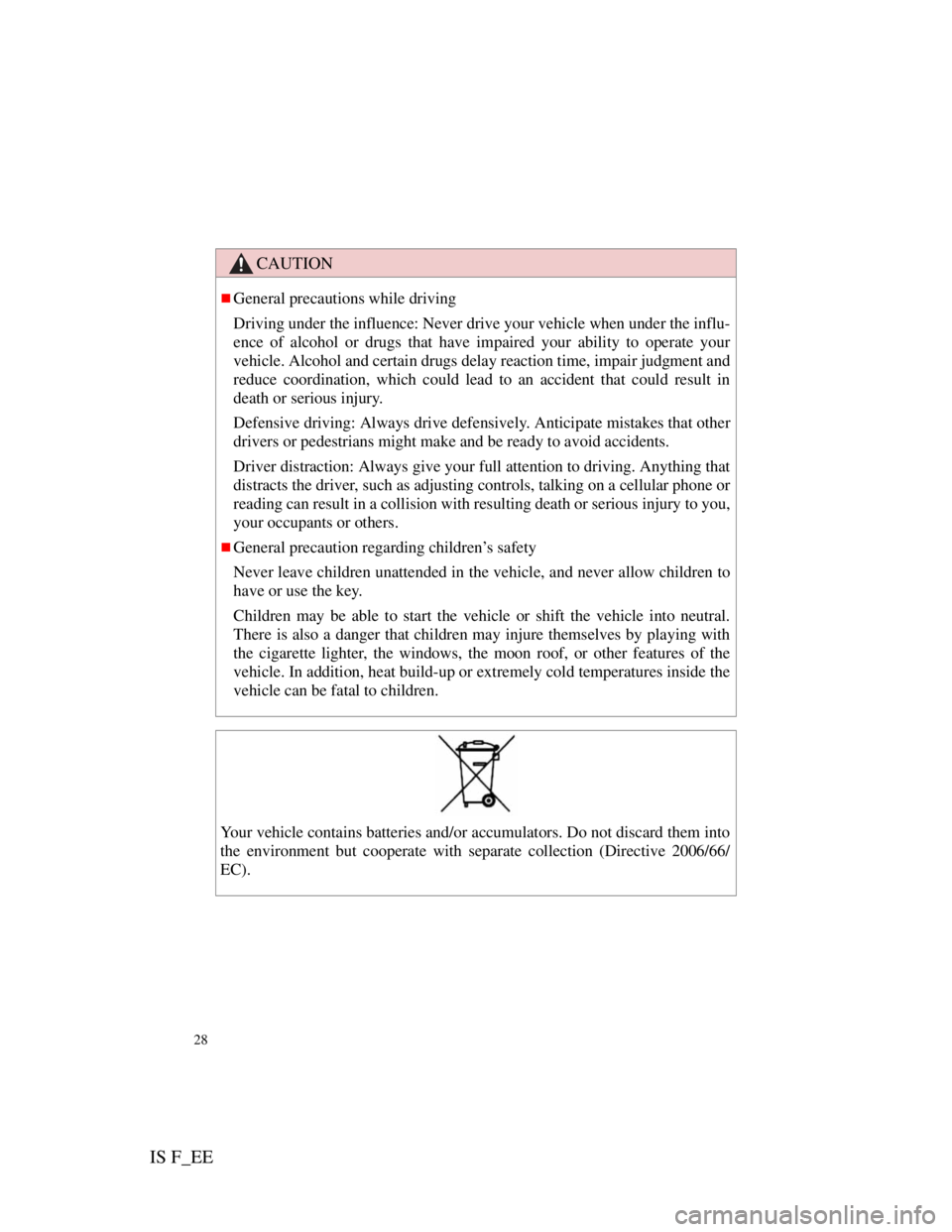
IS F_EE
28
CAUTION
General precautions while driving
Driving under the influence: Never drive your vehicle when under the influ-
ence of alcohol or drugs that have impaired your ability to operate your
vehicle. Alcohol and certain drugs delay reaction time, impair judgment and
reduce coordination, which could lead to an accident that could result in
death or serious injury.
Defensive driving: Always drive defensively. Anticipate mistakes that other
drivers or pedestrians might make and be ready to avoid accidents.
Driver distraction: Always give your full attention to driving. Anything that
distracts the driver, such as adjusting controls, talking on a cellular phone or
reading can result in a collision with resulting death or serious injury to you,
your occupants or others.
General precaution regarding children’s safety
Never leave children unattended in the vehicle, and never allow children to
have or use the key.
Children may be able to start the vehicle or shift the vehicle into neutral.
There is also a danger that children may injure themselves by playing with
the cigarette lighter, the windows, the moon roof, or other features of the
vehicle. In addition, heat build-up or extremely cold temperatures inside the
vehicle can be fatal to children.
Your vehicle contains batteries and/or accumulators. Do not discard them into
the environment but cooperate with separate collection (Directive 2006/66/
EC).
Page 77 of 529
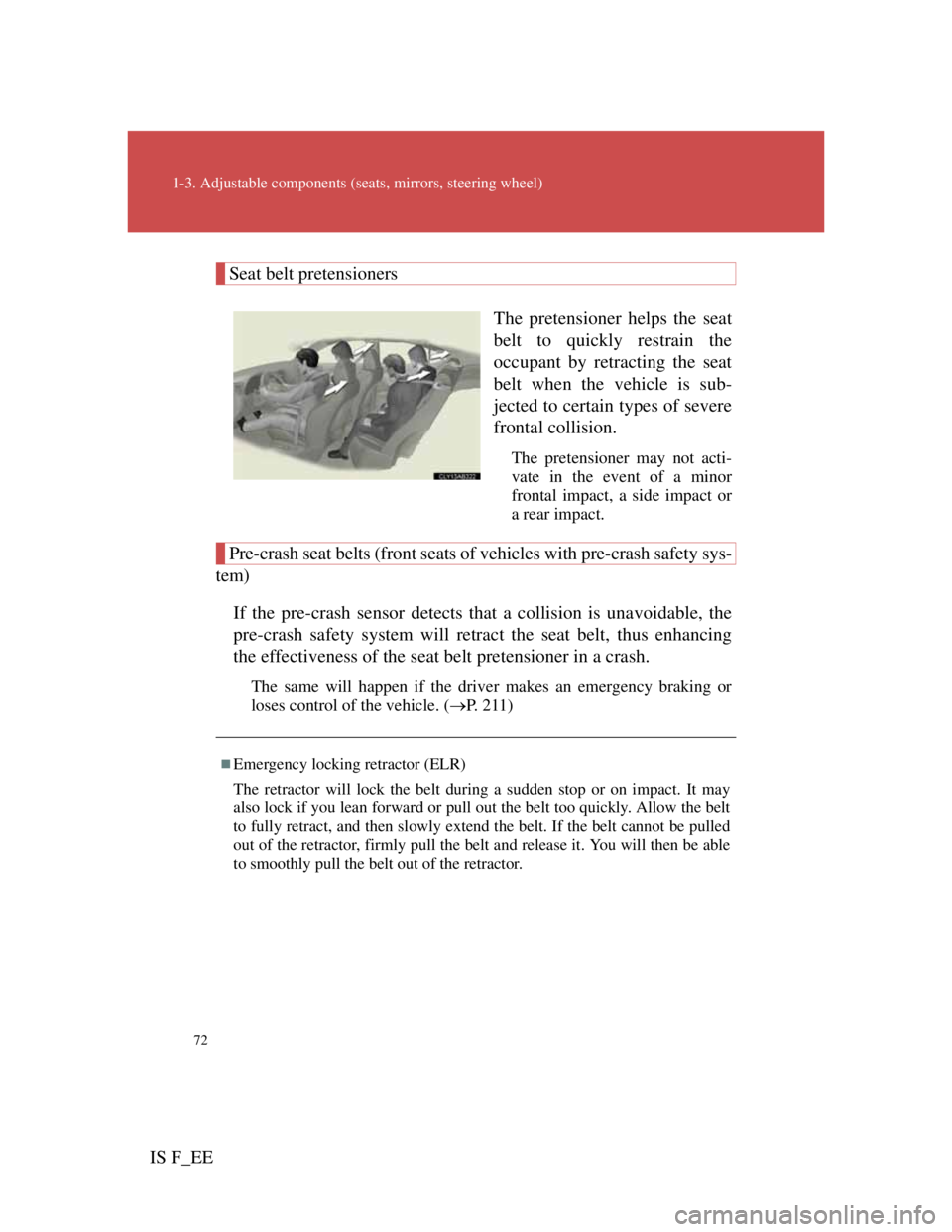
72
1-3. Adjustable components (seats, mirrors, steering wheel)
IS F_EE
Seat belt pretensioners
The pretensioner helps the seat
belt to quickly restrain the
occupant by retracting the seat
belt when the vehicle is sub-
jected to certain types of severe
frontal collision.
The pretensioner may not acti-
vate in the event of a minor
frontal impact, a side impact or
a rear impact.
Pre-crash seat belts (front seats of vehicles with pre-crash safety sys-
tem)
If the pre-crash sensor detects that a collision is unavoidable, the
pre-crash safety system will retract the seat belt, thus enhancing
the effectiveness of the seat belt pretensioner in a crash.
The same will happen if the driver makes an emergency braking or
loses control of the vehicle. (P. 2 1 1 )
Emergency locking retractor (ELR)
The retractor will lock the belt during a sudden stop or on impact. It may
also lock if you lean forward or pull out the belt too quickly. Allow the belt
to fully retract, and then slowly extend the belt. If the belt cannot be pulled
out of the retractor, firmly pull the belt and release it. You will then be able
to smoothly pull the belt out of the retractor.
Page 78 of 529
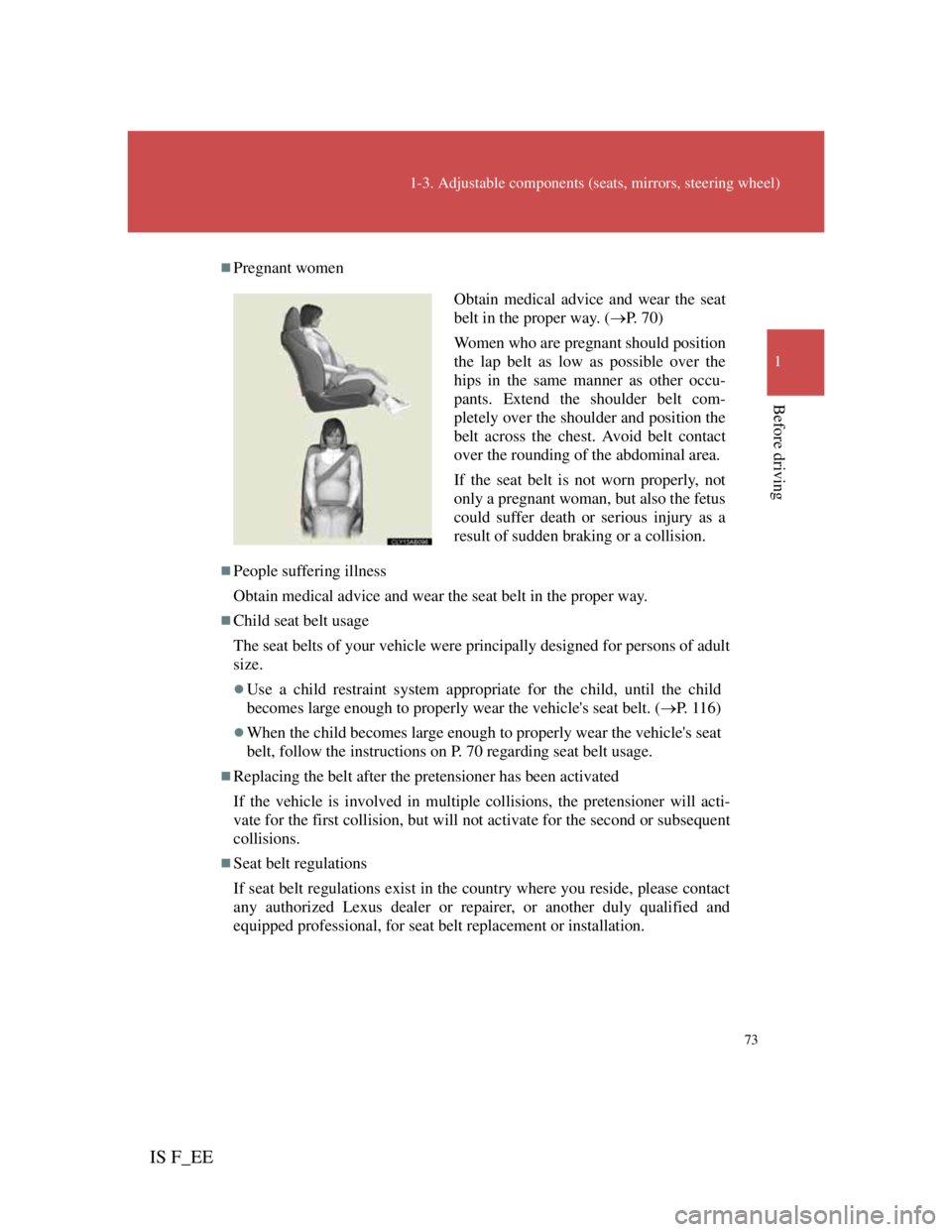
73
1-3. Adjustable components (seats, mirrors, steering wheel)
1
Before driving
IS F_EE
Pregnant women
People suffering illness
Obtain medical advice and wear the seat belt in the proper way.
Child seat belt usage
The seat belts of your vehicle were principally designed for persons of adult
size.
Use a child restraint system appropriate for the child, until the child
becomes large enough to properly wear the vehicle's seat belt. (P. 1 1 6 )
When the child becomes large enough to properly wear the vehicle's seat
belt, follow the instructions on P. 70 regarding seat belt usage.
Replacing the belt after the pretensioner has been activated
If the vehicle is involved in multiple collisions, the pretensioner will acti-
vate for the first collision, but will not activate for the second or subsequent
collisions.
Seat belt regulations
If seat belt regulations exist in the country where you reside, please contact
any authorized Lexus dealer or repairer, or another duly qualified and
equipped professional, for seat belt replacement or installation.
Obtain medical advice and wear the seat
belt in the proper way. (P. 70)
Women who are pregnant should position
the lap belt as low as possible over the
hips in the same manner as other occu-
pants. Extend the shoulder belt com-
pletely over the shoulder and position the
belt across the chest. Avoid belt contact
over the rounding of the abdominal area.
If the seat belt is not worn properly, not
only a pregnant woman, but also the fetus
could suffer death or serious injury as a
result of sudden braking or a collision.
Page 115 of 529

107
1-7. Safety information
1
Before driving
IS F_EE
If the SRS airbags deploy (inflate)
Bruising and slight abrasions may result from contact with a deploying
(inflating) SRS airbag.
A loud noise and white powder will be emitted.
Parts of the airbag module (steering wheel, airbag cover and inflator) as
well as the front seats, and parts of the front pillar, rear pillar and roof
side rail, may be hot for several minutes. The airbag itself may also be
hot.
The windshield may crack.
SRS airbag deployment conditions (front airbags)
The SRS front airbags will deploy in the event of an impact that exceeds
the set threshold level (the level of force corresponding to an approxi-
mately 20 - 30 km/h [12 - 18 mph] frontal collision with a fixed wall that
does not move or deform).
However, this threshold velocity will be considerably higher if the vehicle
strikes an object, such as a parked vehicle or sign pole, which can move or
deform on impact, or if the vehicle is involved in an underride collision
(e.g. a collision in which the front of the vehicle “underrides”, or goes
under, the bed of a truck, etc.).
It is possible that in some collisions where the forward deceleration of
the vehicle is very close to the designed threshold level, the SRS front
airbags and the seat belt pretensioners may not activate together.
SRS airbag deployment conditions (side and curtain shield airbags)
The SRS side airbags and SRS curtain shield airbags will deploy in the
event of an impact that exceeds the set threshold level (the level of force
corresponding to the impact force produced by an approximately 1500 kg
[3300 lb.] vehicle colliding with the vehicle cabin from a direction perpen-
dicular to the vehicle orientation at an approximate speed of 20 - 30 km/h
[12 - 18 mph]).
Page 116 of 529
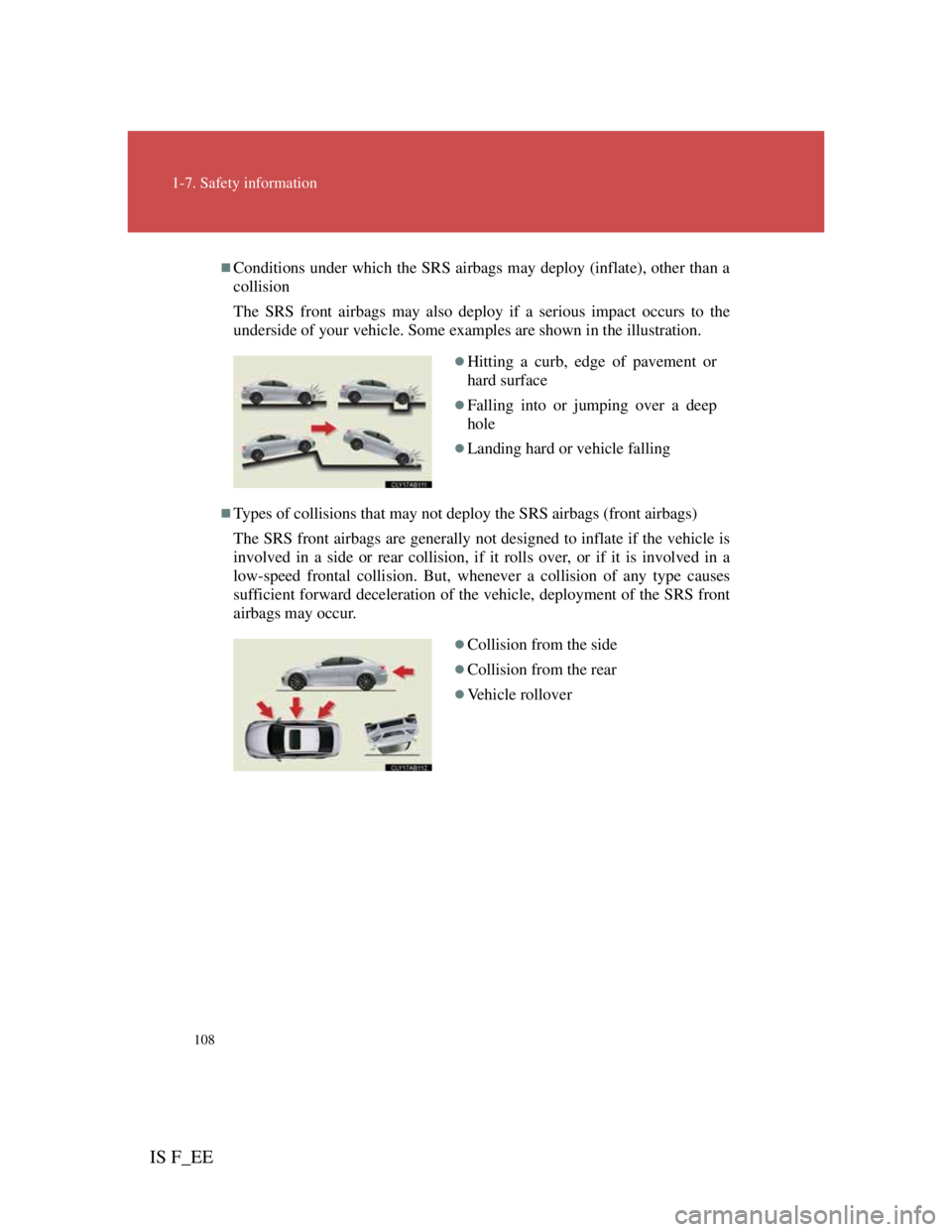
108
1-7. Safety information
IS F_EE
Conditions under which the SRS airbags may deploy (inflate), other than a
collision
The SRS front airbags may also deploy if a serious impact occurs to the
underside of your vehicle. Some examples are shown in the illustration.
Types of collisions that may not deploy the SRS airbags (front airbags)
The SRS front airbags are generally not designed to inflate if the vehicle is
involved in a side or rear collision, if it rolls over, or if it is involved in a
low-speed frontal collision. But, whenever a collision of any type causes
sufficient forward deceleration of the vehicle, deployment of the SRS front
airbags may occur.
Hitting a curb, edge of pavement or
hard surface
Falling into or jumping over a deep
hole
Landing hard or vehicle falling
Collision from the side
Collision from the rear
Vehicle rollover
Page 117 of 529
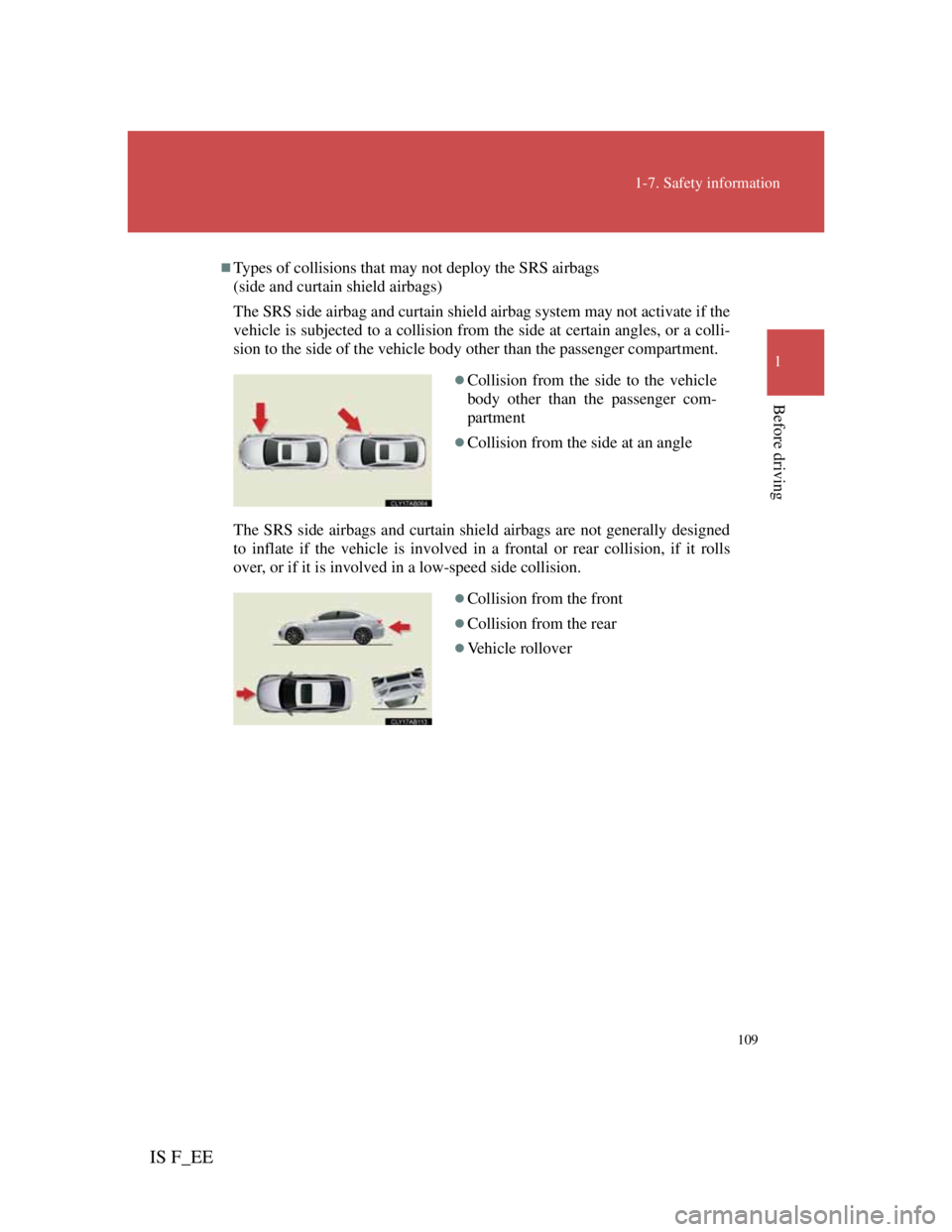
109
1-7. Safety information
1
Before driving
IS F_EE
Types of collisions that may not deploy the SRS airbags
(side and curtain shield airbags)
The SRS side airbag and curtain shield airbag system may not activate if the
vehicle is subjected to a collision from the side at certain angles, or a colli-
sion to the side of the vehicle body other than the passenger compartment.
The SRS side airbags and curtain shield airbags are not generally designed
to inflate if the vehicle is involved in a frontal or rear collision, if it rolls
over, or if it is involved in a low-speed side collision.
Collision from the side to the vehicle
body other than the passenger com-
partment
Collision from the side at an angle
Collision from the front
Collision from the rear
Vehicle rollover
Page 207 of 529

196
2-4. Using other driving systems
IS F_EE
CAUTION
Before using dynamic radar cruise control
Do not overly rely on vehicle-to-vehicle distance control.
Be aware of the set speed. If automatic deceleration/acceleration is not
appropriate, adjust the vehicle speed, as well as the distance between your
vehicle and vehicles ahead by applying the brakes etc.
Cautions regarding the driving assist systems
Observe the following precautions.
Failure to do so may cause an accident resulting in death or serious injury.
Assisting the driver to measure following distance
The dynamic radar cruise control is only intended to help the driver in
determining the following distance between the driver’s own vehicle and
a designated vehicle traveling ahead. It is not a mechanism that allows
careless or inattentive driving, and it is not a system that can assist the
driver in low-visibility conditions. It is still necessary for driver to pay
close attention to the vehicle’s surroundings.
Assisting the driver to judge proper following distance
The dynamic radar cruise control determines whether the following dis-
tance between the driver’s own vehicle and a designated vehicle traveling
ahead is appropriate or not. It is not capable of making any other type of
judgement. Therefore, it is absolutely necessary for the driver to remain
vigilant and to determine whether or not there is a possibility of danger in
any given situation.
Assisting the driver to operate the vehicle
The dynamic radar cruise control has no capability to prevent or avoid a
collision with a vehicle traveling ahead. Therefore, if there is ever any
danger, the driver must take immediate and direct control of the vehicle
and act appropriately in order to ensure the safety of all involved.
To avoid inadvertent cruise control activation
Switch the cruise control off using the “ON-OFF” button when not in use.
Page 224 of 529

213
2-4. Using other driving systems
2
When driving
IS F_EE
PCS (Pre-Crash Safety system)
When the radar sensor detects possibility of a frontal collision, the pre-
crash safety system such as the brakes and seat belts are automatically
engaged to lessen impact and injuries to occupants as well as vehicle
damage.
Pre-crash seat belts
If the pre-crash sensor detects that a collision is unavoidable, the
pre-crash safety system will retract the seat belt before the collision
occurs.
The same will happen if the driver makes an emergency braking or
loses control of the vehicle. (P. 7 2 )
However, the system will not operate in the event of skidding when
the VSC system are disabled.
Pre-crash brake assist
When there is a high possibility of a frontal collision, the system
applies greater braking force in relation to how strongly the brake
pedal is depressed.
Pre-crash braking
When there is a high possibility of a frontal collision, the system
warns the driver using a warning light, warning display and buzzer.
If the system determines that a collision is unavoidable, the brakes
are automatically applied to reduce the collision speed. The pre-
hb ki f i b d d ff i h lli
�
: If equipped
Page 229 of 529

218
2-4. Using other driving systems
IS F_EE
When passing an oncoming vehicle on a right-turn (right-hand drive
countries) or left-turn (left-hand drive countries)
When your vehicle rapidly closes on the vehicle in front
When a grade separation/interchange, sign, billboard, or other structure
appears to be directly in the vehicle's line of travel.
When an overhead billboard or other metallic structure appears to be in
the vehicle’s direct line of travel due to driving on a hill.
When an extreme change in vehicle height occurs
When the axis of the radar is out of adjustment
When passing through certain toll gates
When driving on a bridge.
When the system is activated in the situations described above there is also a
possibility that the seat belts will retract quickly and the brakes will be
applied with a force greater than normal. When the seat belt is locked in the
retracted position, stop the vehicle in a safe place, release the seat belt and
refasten.
When there is a malfunction in the system
Warning lights and/or warning messages will turn on or flash. (P. 425,
431)
Situations in which the pre-crash safety system does not function properly
The system may not function effectively in situations such as the following:
On roads with sharp bends or uneven surfaces
If a vehicle suddenly moves in front of your vehicle, such as at an inter-
section
If a vehicle suddenly cuts in front of your vehicle, such as when overtak-
ing
In inclement weather such as heavy rain, fog, snow or sand storms
When your vehicle is skidding with the VSC system off
When an extreme change in vehicle height occurs
When the axis of the radar is out of adjustment
Automatic cancelation of the pre-crash safety system
When a malfunction occurs due to sensor contamination, etc. that results in
the sensors being unable to detect obstacles, the pre-crash safety system will
be automatically disabled. In this case, the system will not activate even if
there is a collision possibility.
Page 233 of 529

222
2-4. Using other driving systems
IS F_EE
CAUTION
Cautions regarding the assist contents of the system
By means of alarms and brake control, the pre-crash safety system is
intended to assist the driver in avoiding collisions through the process of
LOOK-JUDGE-ACT. There are limits to the degree of assistance the system
can provide, so please keep in mind the following important points.
Assisting the driver in watching the road
The pre-crash safety system is only able to detect obstacles directly in
front of the vehicle, and only within a limited range. It is not a mechanism
that allows careless or inattentive driving, and it is not a system that can
assist the driver in low-visibility conditions. It is still necessary for the
driver to pay close attention to the vehicle’s surroundings.
Assisting the driver in making correct judgment
When attempting to estimate the possibility of a collision, the only data
available to the pre-crash safety system is that from obstacles it has
detected directly in front of the vehicle. Therefore, it is absolutely neces-
sary for the driver to remain vigilant and to determine whether or not there
is a possibility of collision in any given situation.
Assisting the driver in taking action
The pre-crash safety system’s braking assist feature is designed to help
reduce the severity of a collision, and so only acts when the system has
judged that a collision is unavoidable. This system by itself is not capable
of automatically avoiding a collision or bringing the vehicle to a stop
safely. For this reason, when encountering a dangerous situation the driver
must take direct and immediate action in order to ensure the safety of all
involved.